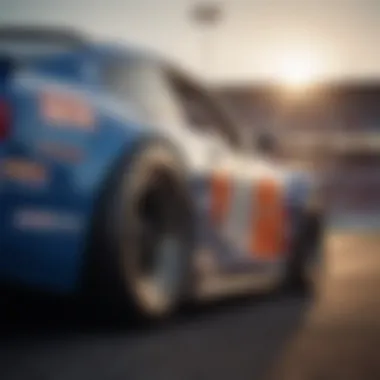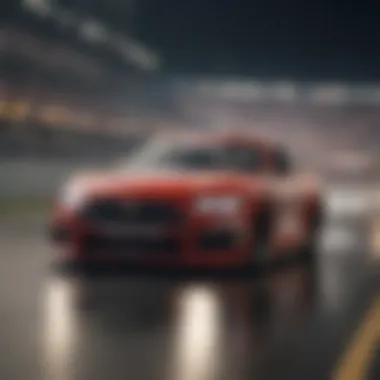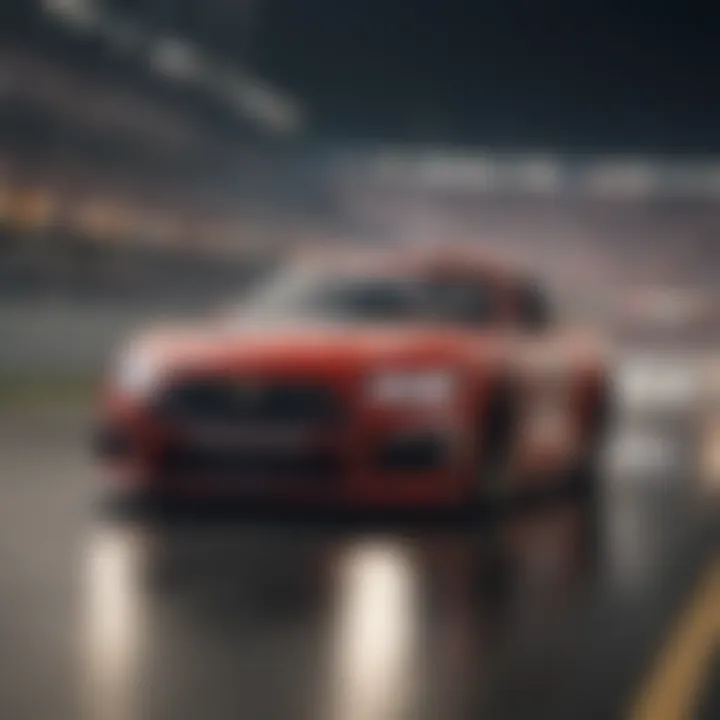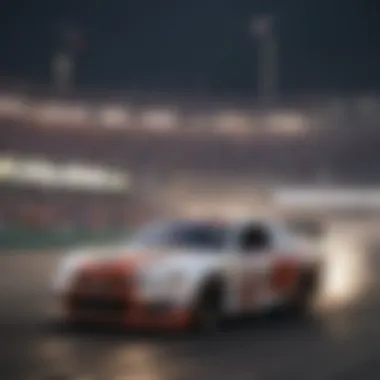Exploring Live Dynamics of NASCAR Racing


Intro
NASCAR, or the National Association for Stock Car Auto Racing, isn’t just a sport; it’s an experience—a cultural phenomenon that captures the imagination of millions. When you think about it, the thrills of roaring engines and the smell of burnt rubber are just part of the magic that takes place during live car racing events. But dive deeper, and you’ll find that these races are intricate operations tied to a rich tradition, a strong community of fans, and a field that embraces modern technology while holding on to its roots.
So, what makes live NASCAR racing distinct? How do the operational dynamics unfold? This article seeks to peel back the layers surrounding NASCAR live events to expose the underlying mechanisms as well as the typical fan experiences that define this exciting motorsport.
From the adrenaline rush of watching cars zoom past at breakneck speeds to the integration of cutting-edge technologies, we’ll cover various aspects that illuminate the relationship between the sport and its observers.
Car Reviews
While NASCAR might seem focused solely on speed and competition, the vehicles themselves carry a story worth exploring. Here we break down key aspects regarding these racing machines.
Overview of the Vehicle
NASCAR racers are a unique breed, designed for precision performance on oval tracks. Unlike commercially available cars, these vehicles are purpose-built. They sport an aerodynamic shape, engineered to minimize drag and maximize stability while at high speeds. Picture the iconic Ford Mustang or Chevrolet Camaro—but take away the logos and put on a custom body that meets racing regulations, which include specifications on weight, engine, and materials.
Performance Analysis
When it comes to performance, NASCAR vehicles are nothing short of impressive. Most stock cars are powered by a V8 engine, capable of churning out upwards of 750 horsepower. They go from zero to sixty in a matter of seconds, reaching top speeds of around 200 miles per hour. But speed is just part of the equation—how these cars handle turns, where lateral forces come into play, adds layers to their performance profile.
Design and Interior Features
The interiors of NASCAR vehicles are stripped down to the essentials. A driver doesn't need luxury features while hurtling around a track at high velocities. You’ll find a fundamental dashboard, a racing seat equipped with a five-point harness, and an array of gauges that provide necessary data in real time.
Safety Ratings and Specifications
Because safety is paramount, NASCAR has established stringent regulations on vehicle design. Each car must include features like a roll cage, fire suppression systems, and specific helmet standards to protect drivers during crashes. In a sport where speed meets danger, these standards save lives.
Value for Money
While the average person may never own a NASCAR racer, the technology and engineering advancements trickle down to commercial automobile models. Manufacturers use insights gained from racing to inform their commercial lines, improving features for consumers. Ultimately, the cost of developing these sophisticated machines is justified by the innovations they inspire in the everyday vehicles we drive.
Automotive Industry Trends
The world of NASCAR doesn’t operate in a vacuum. It’s influenced by shifting currents within the broader automotive landscape.
Emerging Technologies
In NASCAR, technology is woven into the very fabric of competition. From data analytics to telemetry, teams collect information during races to help fine-tune vehicle performance. Moreover, new materials and manufacturing technologies, like 3D printing, are making a mark on vehicle design as well.
Changes in Consumer Preferences
With consumer tastes evolving, manufacturers are mindful of preferences concerning efficiency and performance. Fans of NASCAR find themselves interested in the fuel-efficient options and hybrid technology that may not seem synonymous with the races, yet are becoming relevant in discussions.
Sustainability and Eco-Friendly Practices
Amid rising environmental consciousness, NASCAR has begun to incorporate eco-friendly practices. This shift includes exploring biofuels and working towards sustainable racing. The sport recognizes that the future lies in clean technology, and embracing it could align the fanbase with broader societal values.
Future of Electric Vehicles
There’s a buzz around the potential of electric vehicles (EVs) racing in NASCAR. Discussions are ongoing about introducing hybrid models that can compete in ways that traditional gasoline engines can't. This could not only transform racing strategy but also draw in a new audience.
Industry Challenges and Solutions
As with any industry, NASCAR faces challenges—from economic downturns to changing viewer demographics. However, innovative solutions, like enhanced fan interactions through technology, are helping to keep engagement high.
"Innovation in motorsport reflects what consumers desire in their daily vehicles. It's a two-way street."
Understanding the dynamics of NASCAR car racing isn't just about the races themselves; it's about the expertise, technology, and traditions that come together to create a unique spectacle.
Stay tuned as we continue to dive deeper into more aspects of this grand tradition, from car launches to insights into top drivers. The world of NASCAR is complex and multifaceted, and it deserves to be explored from many angles—both on and off the track.
Foreword to NASCAR
NASCAR isn’t just a racing series; it’s a vital thread in the fabric of American auto culture. Understanding its significance is crucial as it sets the stage for comprehending the intricate lives of the live racing experience. As we peel back the various layers of NASCAR's history and evolution, it becomes evident why this sport commands such a dedicated following across the nation.
NASCAR’s Origins and Evolution
NASCAR, officially established in 1948, grew from the grassroots racing scenes in the southeastern United States. The origins can be traced back to bootleggers who modified their vehicles to evade law enforcement during Prohibition. This unlicensed racing fostered a spirit of competition and ingenuity. The transformation from a localized pastime to a nationwide phenomenon was nothing short of remarkable.
Key milestones in its evolution include:


- The first race in 1949 at the Charlotte Motor Speedway, where a new form of organized stock car racing took shape.
- The introduction of the NASCAR Cup Series in the early 1970s, which elevated the sport to a new level, providing a more structured racing calendar and paving the way for professional drivers.
- The launch of the television broadcasts in the 1970s that brought the excitement into living rooms and heightened fan engagement.
As the sport evolved, so did the cars themselves. From the classic Ford, Chevy, and Dodge models to today’s sophisticated speed machines, NASCAR vehicles reflect both the technological advancements in automotive engineering and the breathing competitive spirit. The rules also adapted over the years to enhance safety and foster a competitive spirit while ensuring that the races remain high-octane entertainment.
The Significance of Live Racing
Live racing has integral importance beyond simply showcasing cars on a track. It’s where fans feel the thunderous roar of engines, smell the burning rubber, and experience the adrenaline rush of tight cornering and overtaking maneuvers firsthand.
Key aspects to consider include:
- Community Engagement: Attending a NASCAR race is more than spectating; it’s about communal experience. Fans gather to share in the thrill, creating a collective atmosphere that fuels the energy of the event.
- Economic Impact: Live racing events significantly contribute to local economies, with increased tourism, hospitality, and retail activity during race weekends.
- Cultural Significance: Live races form the connective tissue that binds fans and diverse groups together under the NASCAR banner, showcasing the rich tapestry of American culture.
"NASCAR races are as much about the spectacle as they are about mechanics and speed; they represent an experience that’s deeply woven into the everyday lives of its fans."
In an era where digital experiences often overshadow physical ones, the nostalgia and authenticity of live NASCAR racing remains uniquely compelling. It embodies a celebration of speed, excitement, and traditions that resonate with audiences both old and new. By understanding these origins and the significance behind live events, readers gain a clearer picture of why NASCAR holds such an esteemed place in American sports.
The Structure of a NASCAR Race
Understanding how a NASCAR race is structured is fundamental for both fans and newcomers alike. The race structure, including formats and key components, not only shapes the competition but also enhances the excitement and engagement that comes with live racing. It intertwines various elements to create a gripping narrative, one that unfolds lap by lap. Examining this structure helps illuminate the depth of strategy and the skills required, which are often overlooked by casual observers.
Understanding Race Formats
Race formats in NASCAR are not just technical specifics; they act as the blueprint for the entire event, setting a framework that dictates how teams will strategize. A typical NASCAR race can vary significantly, ranging from a straight 500-mile dash to longer endurance style events like the Coca-Cola 600. Each format brings its own set of rules and strategies, making each race a fresh challenge.
Some formats include qualifying races that determine starting positions, while others may implement stages that create mini-races within the longer event. This diversity in format keeps things interesting and allows for unique storylines to emerge from every race. Understanding these formats can provide fans deeper insights and appreciation for what drivers and teams experience on race day.
Key Components of the Race
Diving deeper into the structure of a NASCAR race, three key components warrant attention: qualifying rounds, pit stops, and race strategy. Each of these elements plays a crucial role in either determining the outcome or influencing the tactics employed by teams.
Qualifying Rounds
Qualifying rounds serve as a litmus test for racing teams, determining the positions they will start in the main race. This is a high-stakes challenge. Failing to secure a good position can put a team at a severe disadvantage right from the get-go. The speed achieved during qualifying rounds reflects the car's performance and the driver's skill, making it a critical factor for the upcoming race.
A notable characteristic of qualifying rounds is the time trial system, where drivers are pushed to squeeze the most speed out of their vehicles for just a few laps. This pressure cultivates an environment where split-second decisions can change the race's outcome. However, it can also pose risks; sometimes the pursuit of speed can lead to mishaps, resulting in damaged cars before the main event even starts. This unpredictability of qualifying rounds can heighten tension levels, making it an enthralling part of the NASCAR race weekend.
Pit Stops
Pit stops are another essential component of a NASCAR race that can greatly influence the outcome. These are brief pauses during the race for refueling, tire changes, and minor repairs. The efficiency and speed of a pit crew can mean the difference between winning and losing.
A defining trait of these stops is that they often occur under pressure, where a team has mere seconds to execute their plan flawlessly. A well-timed pit stop can allow a driver to gain track position, while a slow or botched stop could leave them languishing in the pack. Thus, the coordination and communication among team members hold an invaluable role during these crucial moments. However, timing becomes a gamble, as taking a pit stop at the wrong time can also leave a team exposed during critical race moments.
Race Strategy
Race strategy encompasses the broader tactical approach a team employs throughout the race. It's about harnessing the right moment to push hard or conserve fuel, and choosing when to take pit stops, based on various unpredictable factors like weather and competitor movements.
One key characteristic of race strategy is its fluid nature. As the race progresses, teams often have to adjust their plans based on real-time developments. For instance, if a caution flag comes out, it may prompt some teams to pit while others choose to stay out, influencing not just their race position but also their long-term strategy for the remainder of the event. This aspect illustrates how NASCAR is not merely a test of speed but also of intelligence and adaptability, rewarding those who can think on their feet.
In essence, the structure of a NASCAR race forms a complex web of involvements that affects every aspect, from team dynamics to fan experience.
"Understanding the structure is akin to peering under the hood of a race car; the more you know about the mechanics, the more thrilling the ride becomes."
As we delve into the interplay of technology in live racing, we will further explore how these foundational components are transformed into a spectacle viewed by millions.
Technology’s Role in Live Racing
Technology has woven itself into the fabric of NASCAR racing live, impacting every facet from broadcasting to the relationship between fans and the sport. The integration of advanced technologies has not only transformed how races are experienced but has also reshaped the business model of racing. Understanding these dynamics is crucial to grasping the current relevance and future potential of NASCAR as an entertainment platform.
Broadcasting Innovations
Camera Technologies
The evolution of camera technologies reshapes how audiences view live NASCAR events. High-definition cameras fitted within cars and on the racetrack provide striking visuals, capturing every curve and bump of the race. The use of aerial drones has introduced a level of perspective never seen before, showcasing the grandeur of the track while spotting action from angles that traditional methods would miss.
One key characteristic of this technology is the 360-degree camera, which brings immersive experiences right to the viewers’ screens. While it excels in providing a comprehensive viewpoint of a race, one drawback might be the distractions it could create with excessive angles. Even so, for a sport rooted in speed and precision, such innovations serve to not only enhance viewing pleasure but also inform viewers about critical moments that could influence outcomes.
Data Analytics
Data analytics stands as a cornerstone of modern racing strategies, allowing teams to dissect every aspect of performance. The ability to analyze lap times, pit stop efficiency, and tire wear empowers crews to make informed decisions in real-time. The merging of analytics with on-track performance is where its strength lies, contributing immensely to a team's competitive edge.
It’s pivotal in recognizing patterns and predicting future outcomes based on historical data. A significant advantage of this technology is its relentless commitment to precision; teams can fine-tune their strategies before, during, and after races. However, quite often, it involves complexities that can be daunting for casual fans, as jargon and intricate analyses are not easy to digest. Nevertheless, the tactical insights data analytics provides cannot be overstated—it has fundamentally changed how races are won.
Fan Engagement Technologies


Mobile Apps
Mobile applications have become indispensable tools for fans, creating a bridge between the racetrack and the audience. With these apps, fans can access live stats, driver updates, and interactive features right from their smartphones. Key features such as live race tracking and personalized notifications make it easier for fans to stay in the loop, regardless of their geographical location.
The advent of these apps has revolutionized accessibility, enabling more fans to engage with the event remotely. Yet, there’s a flip side; not all fans may find technology comfortable, particularly older generations not as savvy with mobile devices. Despite this, the overall impact of mobile apps in enhancing the live experience cannot be denied—it's a significant leap that puts information at your fingertips.
Social Media Platforms
Social media has established itself as a critical component of modern sports engagement, and NASCAR is no exception. Platforms like Facebook, Twitter, and Instagram offer unprecedented communication channels that bring fans, athletes, and officials closer together. This real-time interaction enables fans to share their experiences, garner exclusive insights, and participate in live discussions during races.
One unique feature is the live chat functions during broadcasts, allowing fans to engage not only with one another but also with the drivers’ teams. This interactivity opens doors to new levels of engagement. However, distractions from overwhelming content and the inevitable social media noise can dilute the racing experience. If employed judiciously, the advantages of participating in a broader community outweigh these downsides.
"Ultimately, the fusion of technology with NASCAR not only augments the spectator experience but also drives change in the sport’s competitive nature, charting a course into the future that few could have predicted."
In summation, the role of technology in NASCAR live racing is transformative. By enhancing the viewing experience and creating efficient engagement methods, NASCAR continues to evolve, attracting a broader audience while keeping long-time fans invested. As we proceed further, understanding these technological shifts will be critical in navigating what lies ahead in this high-octane world.
The Live Race Experience
When it comes to NASCAR, the live race experience holds a unique place in the hearts of fans. It’s not just about the roar of engines or the smell of tire rubber; it's a blend of thrill, emotion, and community engagement. Whether it’s in-person attendance at the racetracks or watching from the comfort of one’s home, each offers its own set of advantages and nuances. Understanding the live race experience is essential for grasping how NASCAR creates and preserves its unique culture and what keeps it relevant in an ever-evolving sports landscape.
In-Person Attendance
Stadium Setup
In-person attendance at NASCAR races is an energy-packed experience. The setup of stadiums, often designed with the fans in mind, plays a crucial role in this atmosphere. Ranging from grandstands that offer optimal visibility to expansive concession areas, each component is thoughtfully arranged to enhance the encounter.
One key characteristic is how stadiums are often designed with multiple viewing angles. Fans can see everything from pit stops to the track, which allows for a more immersive experience. The unique feature of elevated seating provides spectators an unobstructed view of the action, which is not just a benefit but often a necessity in a sport this fast-paced. However, it does come with some disadvantages, like sometimes being far from the action when a crash occurs, leading to a more distant emotional investment in the events unfolding on the track.
Community and Fan Interaction
Community and fan interaction form the backbone of the NASCAR experience. One of the most impressive aspects is the sheer camaraderie felt in the stands, where people from various backgrounds come together to root for their favorite drivers. This sense of belonging is a hallmark of NASCAR, making it a more personal sport than many others.
Key characteristic here includes the various fan zones and interactive areas present during the race days. These spaces allow fans to engage with sponsors, experience merchandise hands-on, and interact with drivers during meet-and-greet sessions. A unique feature is the accessibility buried within the community setup—often fans can walk pit road during designated times, bridging the gap between them and the teams. While this direct contact fosters enhanced emotional ties, it can make the experience feel overwhelming for newcomers who might not know how to navigate the crowd or where to find specific attractions.
Watching from Home
Television Broadcasts
Television broadcasts are a staple for NASCAR fans who either can’t make it to the track or prefer the comfort of their own homes. Broadcasting features such as comprehensive race coverage and insightful commentary enhance the viewer's understanding of the dynamics on the track. The convenience of being able to pause the broadcast or rewind is a major advantage of choosing this route, not to mention that a well-positioned couch beat bleacher seats on a rainy day.
The key characteristic of television broadcasts lies in their ability to present multiple angles and slow-motion replays. Viewers can see every nuance, from strategic pit stops to thrilling finishes. However, the downside is that it may lack the visceral thrill of the live crowd, which can mute the adrenaline rush one feels in person amidst the roaring engines and cheering fans.
Online Streaming Services
In today’s world, online streaming services represent a modern choice for catching NASCAR races live. Platforms such as NBC Sports and FS1 offer live streams that can be accessed on various devices, breaking down geographical barriers which might hinder some fans from seeing the races live. The convenience this brings adds another layer to the overall experience, showcasing how technology adapts to meet the needs of the audience.
A significant key characteristic of streaming is the ability for fans to engage with interactive features, such as real-time stats and camera angles of their choosing. This furnishes a custom experience that can cater to individual preferences. Nonetheless, the disadvantage can include reliance on stable internet connections—any hiccup can disrupt the viewing experience, leaving fans on edge instead of fully immersed.
"The essence of NASCAR lies not just in the race but in how it weaves together the fabric of community and shared joy among its followers."
Economic Aspects of NASCAR
The economic implications of NASCAR stretch far beyond the racing circuits. This section delves into how NASCAR, as a sport, exercises a profound influence on local economies and industry partnerships. Understanding these facets enriches our appreciation of how live racing events serve not just fans but also the wider economic landscape. The financial flow generated by these events, coupled with the strategic alliances formed across various sectors, plays a pivotal role in sustaining the sport and promoting growth.
Financial Impact on Local Economies
Local economies often see a significant boost during NASCAR events. Take Talladega, Alabama, for instance; when the Talladega Superspeedway is in full swing, hotels fill up faster than a race car zooming down the track. Restaurants, shops, and gas stations profit immensely, transforming the town into a bustling hub of economic activity, even if just for a weekend.
The economic impact can be broken down into several key areas:
- Job Creation: Local events generate temporary jobs, from ticket sales to food vendors. This increases employment opportunities for residents, even if they are seasonal.
- Increased Revenue: Merchants often report a surge in sales, whether it's local eateries serving hot dogs or souvenir shops selling branded merchandise.
- Infrastructure Development: The regular influx of fans often prompts towns to invest in roads and facilities to better accommodate the increased traffic.
In essence, hosting a NASCAR event can positively change the financial future for many local businesses, as these events draw crowds that help increase foot traffic substantially. As NASCAR fans descend upon a city, they're not just supporters of a sport; they're contributors to its economic ecosystem.
Sponsorships and Partnerships
Sponsorship in NASCAR runs thicker than motor oil. Whether it's Monster Energy or Goodyear, big brands align themselves with the sport to capitalize on the massive viewership and fan dedication. These partnerships not only bring in valuable funding but also valuable marketing exposure for the companies involved.
Here are some significant points about sponsorships in NASCAR:
- Brand Visibility: From car wraps to uniforms, logos are prominently displayed, which creates a direct connection between fans and sponsoring brands. This can foster brand loyalty among fans, as they often identify strongly with the drivers and their sponsors.
- Tap into Diverse Demographics: Companies evaluate various aspects of the sport, such as viewer demographics, to target specific groups effectively. For example, an outdoor gear brand might sponsor a race at a track known for attracting adventurist fans.
- Innovative Marketing Strategies: Brands often employ creative marketing strategies that engage fans directly during races. This can include interactive campaigns through social media or even events at the racetrack itself, such as meet-and-greets with drivers.
The partnership dynamics in NASCAR highlight the importance of aligning business interests with the vibrant culture surrounding the sport. Companies leverage NASCAR to not only showcase their products but also to ingratiate themselves with a passionate community, making sponsorship a crucial element for both the sport’s and the brands’ successes.


In the grand scheme of things, NASCAR acts as a megaphone for brands, amplifying their messages to millions while simultaneously serving as an economic engine for the locales that host these exhilarating events.
Cultural Implications of NASCAR Racing
NASCAR is more than just cars going around in a circle; it's a reflection of American culture that weaves together community, tradition, and a healthy dose of competition. The significance of NASCAR in society extends beyond the tracks, influencing everything from advertising to regional identities. Understanding these cultural implications helps to illuminate why this sport endures, despite the changing landscape of media and entertainment.
NASCAR in American Pop Culture
NASCAR holds a revered spot in the fabric of American pop culture. Through movies, music, and television, the thrilling world of fast cars and roaring engines has found its way into the hearts of many. Who can forget the classic flick "Days of Thunder"? It's not just a movie about racing; it captures the ambitions, struggles, and excitement of the sport, drawing in both fans and casual viewers alike. Here are some key aspects of NASCAR's integration into pop culture:
- Film and Television: Aside from dramatic blockbusters, NASCAR events often feature in sports documentaries and reality shows. The authenticity of behind-the-scenes footage appeals to audiences who seek a deeper connection with the sport.
- Music: Country music often reverberates through NASCAR venues, celebrating the lifestyle that surrounds fans. Popular songs referencing drivers and races find their way onto playlists in homes and at tailgating parties.
- Brands in Film: You see everything from Goodyear tires to the iconic Monster Energy drink, making these brands a household name through their association with the sport.
With such ties, NASCAR recently showcased the cultural fabric of small-town America, sprouting connections between fans and the racers they idolize.
Diversity and Inclusion in NASCAR
While NASCAR has long been seen as a predominantly white and male domain, the tides are turning, and the push for diversity within the sport is gaining momentum. Efforts to promote inclusion are becoming more visible and crucial as the face of America evolves. Here are some considerations regarding diversity and inclusion in NASCAR:
- Drivers and Leadership: There’s been a conscious effort to bring more diverse drivers into the competition. Figures like Darrell "Bubba" Wallace Jr. have paved the way, becoming role models for aspiring racers from different backgrounds. The leadership within NASCAR has also started reflecting a more inclusive perspective, which is essential for future growth.
- Community Engagement: NASCAR is engaging with historically black colleges and universities, forging partnerships that empower young people in underserved communities. This strategy gives future talent a legitimate platform to explore racing careers, often untouched before.
- Fan Base Expansion: Expanding the demographics of fans not only enriches the experience at the races but also opens opportunities for sponsorships and partnerships targeting a broader audience. By incorporating diverse voices and enhancing the narrative around the sport, NASCAR is making strides toward inclusivity.
"Embracing diversity isn’t just a trend; it’s a pathway to a thriving community that fosters innovation and growth within the sport."
Challenges Facing NASCAR
The world of NASCAR racing does not just revolve around roaring engines and flashing lights; it faces its share of hurdles, ones that could shape its future and affect its fan base. It's crucial to dissect these challenges because they reveal how the sport is adapting to changing times while navigating through tough waters. Understanding these issues provides fans and stakeholders with insights into the current dynamics of NASCAR car racing. Let's delve into the two significant areas affecting the sport today: environmental concerns and changing audience demographics.
Environmental Concerns
The NASCAR ecosystem is intertwined with the environment more than many might realize. The sport generates a substantial carbon footprint due to fuel emissions, tire wear, and the overall energy consumption that comes with hosting large events. As society becomes more eco-conscious, the call for cleaner practices in all industries, including motorsports, is growing louder. NASCAR is not immune to this rising awareness.
Key Points to Consider:
- Resource Usage: Each race contributes to the demand for gasoline and new tires, which can strain natural resources.
- Waste Management: Events generate considerable waste, from discarded tires to food waste in sprawling race venues.
- NASCAR's Initiatives: Notably, NASCAR has taken steps towards sustainability. The introduction of biofuels, for instance, showcases a commitment to reducing environmental impact.
The sport’s leaders are already eyeing potential changes to make racing greener. There's ongoing research focused on ways to integrate electric vehicle technology into NASCAR races. While transitioning to electric racing cars remains a daunting task, the potential benefits for the environment and the brand's image are substantial.
Changing Audience Demographics
The demographic makeup of NASCAR's audience is changing, much like the world around us. Historically, NASCAR attracted a predominantly Southern, white male audience. However, as society grapples with issues of representation and inclusiveness, the sport is recognizing the need to evolve its approach to attract a broader base of fans.
Considerations on Changing Demographics:
- Diversity: Attracting a more diverse fan base involves welcoming individuals from different racial and cultural backgrounds. The push for diversity has led to initiatives such as the Drive for Diversity program, which aims to increase the number of minority participants in NASCAR—a move crucial for its survival.
- Youth Engagement: With younger fans being more socially conscious, NASCAR's age demographic is aging. If the sport doesn't appeal to the younger crowd, it risks losing their interest altogether. Social media strategies and partnerships can help in promoting more inclusive messages and engaging content.
- New Viewing Habits: The way in which younger audiences consume media has shifted dramatically. Traditional television is giving way to streaming services and social platforms. NASCAR must address these shifts and adapt its broadcasting strategies to connect with a digitally savvy audience.
"Adapting to the change is as essential as handling the tight turns on a racetrack; without it, NASCAR could lose its place in the fast lane of American sports culture."
The Future of NASCAR
The landscape of NASCAR is ever-changing, and its future remains a hot topic of discussion among fans, analysts, and industry stakeholders. This section aims to unpack the evolving dynamics within the sport, shedding light on how it plans to adapt and thrive in an increasingly competitive environment. From innovative race formats to the infusion of cutting-edge technology, various elements will play crucial roles in shaping the future of NASCAR.
Evolving Race Formats
The race formats in NASCAR have always been a foundation of its appeal, but as time marches on, the necessity for change becomes clear. The Nissan Formula, for instance, has started to introduce hybrid elements, focusing on shorter bursts of intense competition rather than long hours on the track. This shift captures a younger audience's attention, stemming from an increasing preference for faster-paced events over prolonged experiences.
This focus on adaptability doesn't only relate to time. The spatial dimension of races is also up for discussion. Future tracks may include more multi-tier layouts, allowing for simultaneous cutthroat racing encounters, leading to thrilling spectacles that enhance drama and viewer engagement.
Moreover, elements like stage racing are being considered for deeper integration, reinforcing a strategy where teams need to plan carefully for cumulative points not just from the final outcome, but from the entire competition. These evolving formats aim to draw in diverse spectators, providing not just a race but a varied experience that captures the excitement of NASCAR in different fashions.
Technology Integration
Technology is the backbone of contemporary racing, providing tools for both teams and fans. Its integration into NASCAR is poised to dramatically alter how the sport engages with its audience. With a surge in mobile app usage and real-time data analysis, NASCAR can offer a seamless connection between the race and the fan experience.
Electric Vehicles in NASCAR
Electric vehicles are gradually becoming a talking point in racing circuits worldwide. In NASCAR, the exploration of electric vehicles brings forth a fascinating blend of innovation and tradition. The potential for electric cars to enter the NASCAR realm opens doors to sustainability and environmental responsibility, a vital consideration as climate awareness grows. NASCAR's willingness to explore this could modernize its image while addressing pressing uproaching concerns about emissions and fuel consumption.
The key characteristic of electric vehicles in this context lies in their torque delivery—providing immediate power without the need for a turbo boost. This potential for instant acceleration can revolutionize racing strategies, where split-second decisions determine outcomes. However, with advantages also come disadvantages: the challenge of battery life during races poses logistical concerns that must be tackled effectively.
Enhanced Viewing Experiences
As technology continues to deepen its roots within NASCAR, the concept of enhanced viewing experiences becomes progressively relevant. Existing tools and new-age innovations promise to engage fans like never before. Imagine a scenario where augmented reality overlays provide insight into driver strategy, or where virtual screens in stadiums allow outside fans to follow race metrics in live 3D!
Highlighting the characteristic aspects of such experiences, the use of drones for aerial views adds a completely new dimension to how the spectators consume races. These enhancements could invite fans into the action or provide scope beyond the standard behind-the-wheel view. However, seamless integration remains crucial. Should the technology be clunky or distraction-heavy, it could lead to viewers feeling overwhelmed instead of enthralled.
In sum, the future of NASCAR lies in a balance between maintaining the sport's rich history while embracing the changes that the progressive forces of technology and audience expectations bring. Each iteration of racing formats, the exploration of electric vehicles, and enhanced viewing solutions points toward a vibrant evolution of what NASCAR could become in the years to come.
"Theory alone does not shape the future; it is the actions stemming from these theories that define what lies ahead."
As NASCAR looks ahead, it must remain pliable, yet firm in its identity, paving the way for innovation that exhilarates and welcomes all automotive enthusiasts, making it a truly exciting era for the sport.







